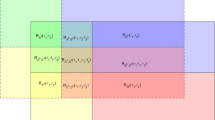Abstract
Dense femtocell deployment in macrocell system is an important tendency in future cellular networks due to the increasing demand in indoor communications, where the cross-tier interference mitigation between the macrocell and femtocells is one of the most critical issues. However, the current studies mostly focus on the cross-tier interference in two-dimensional scenarios with a few works considering the tridimensional cell. In this paper, based on the traditional fractional frequency reuse (FFR) method, we propose a simple yet effective tridimensional frequency reuse strategy to mitigate the cross-tier interference in two-tier femtocell networks. We analyze the performance of the proposed strategy and present the theoretical expression of the interference and the data rate. Moreover, we compare it with the traditional FFR method and the original co-channel method. Simulation results show the huge gain achieved by our proposed strategy and demonstrate its effectiveness on interference mitigation in the tridimensional cell.














Similar content being viewed by others
References
Cisco Public. (2015). Cisco visual networking index: Global mobile data traffic forecast update 2014–2019 white paper. Press release, 3rd Feb. 2015, online available.
Zahir, T., Arshad, K., Nakata, A., & Moessner, K. (2013). Interference management in femtocells. IEEE Communications Surveys and Tutorials, 15(1), 293–311.
Ahmed, A. U., Islam, M. T., & Ismail, M. (2014). A review on femtocell and its diverse interference mitigation techniques in heterogeneous network. Wireless Personal Communications, 78(1), 85–106.
Golaup, A., Mustapha, M., & Patanapongpibul, L. B. (2009). Femtocell access control strategy in UMTS and LTE. IEEE Communications Magazine, 47(9), 117–123.
Bao, W., & Liang, B. (2015). Stochastic analysis of uplink interference in two-tier femtocell networks: Open versus closed access. IEEE Transactions on Wireless Communications, 14(11), 6200–6215.
López-Pérez, D., Güvenç, S., De la Roche, G., Kountouris, M., Quek, T. Q., & Zhang, J. (2011). Enhanced intercell interference coordination challenges in heterogeneous networks. IEEE Wireless Communications, 18(3), 22–30.
López-Pérez, D., Valcarce, A., De La Roche, G., & Zhang, J. (2009). OFDMA femtocells: A roadmap on interference avoidance. IEEE Communications Magazine, 47(9), 41–48.
Ismail, M., & Zhuang, W. (2012). A distributed multi-service resource allocation algorithm in heterogeneous wireless access medium. IEEE Journal on Selected Areas in Communications, 30(2), 425–432.
Chandhar, P., & Das, S. S. (2014). Area spectral efficiency of co-channel deployed OFDMA femtocell networks. IEEE Transactions on Wireless Communications, 13(7), 3524–3538.
Riihijärvi, J., Mähönen, P., & Petrova, M. (2016). What will interference be like in 5G HetNets? Physical Communication, 18, 85–94.
Alfarhan, F., Lerbour, R., & Le Helloco, Y. (2015). An optimization framework for LTE eICIC and reduced power eICIC. In 2015 IEEE global communications conference (GLOBECOM) (pp. 1–6).
Kim, D. I., Shin, E. H., & Jin, M. S. (2015). Hierarchical power control with interference allowance for uplink transmission in two-tier heterogeneous networks. IEEE Transactions on Wireless Communications, 14(2), 616–627.
Ma, B., Cheung, M. H., Wong, V. W., & Huang, J. (2015). Hybrid overlay/underlay cognitive femtocell networks: A game theoretic approach. IEEE Transactions on Wireless Communications, 14(6), 3259–3270.
Ebrahim, A., & Alsusa, E. (2015). Interference minimization through sleep mode based resource allocation for future femtocell networks. In 2015 IEEE international conference on communications (ICC) (pp. 1679–1684).
Saquib, N., Hossain, E., Le, L. B., & Kim, D. I. (2012). Interference management in OFDMA femtocell networks: Issues and approaches. IEEE Wireless Communications, 19(3), 86–95.
Jin, F., Zhang, R., & Hanzo, L. (2013). Fractional frequency reuse aided twin-layer femtocell networks: Analysis, design and optimization. IEEE Transactions on Communications, 61(5), 2074–2085.
Jacob, P., & Madhukumar, A. S. (2016). Handling interference in self-organizing femtocell networks through frequency-polarization diversity. Wireless Networks, 22(2), 383–401.
Oh, C. Y., Chung, M. Y., Choo, H., & Lee, T. J. (2013). Resource allocation with partitioning criterion for macro-femto overlay cellular networks with fractional frequency reuse. Wireless Personal Communications, 68(2), 417–432.
Letourneux, F., Corre, Y., Suteau, E., & Lostanlen, Y. (2012). 3D coverage analysis of LTE urban heterogeneous networks with dense femtocell deployments. EURASIP Journal on Wireless Communications and Networking, 2012(1), 1–14.
Jagadeesan, S., Riihijarvi, J., & Petrova, M. (2015). Impact of three-dimensionality of femtocell deployments on aggregate interference estimation. In 2015 IEEE 26th annual international symposium on personal, indoor, and mobile radio communications (PIMRC) (pp. 737–742).
Liu, J., Kou, T., Chen, Q., & Sherali, H. D. (2012). Femtocell base station deployment in commercial buildings: A global optimization approach. IEEE Journal on Selected Areas in Communications, 30(3), 652–663.
Jiming, C., Peng, W., & Jie, Z. (2013). Adaptive soft frequency reuse scheme for in-building dense femtocell networks. China Communications, 10(1), 44–55.
Dan, H. U., Li, H. J., Xu, X. D., & Tao, X. F. (2012). Inter-femtocell interference coordination in 3D in-building scenario. The Journal of China Universities of Posts and Telecommunications, 19(2), 36–66.
Al-omari, M., Ramli, A. R., Sali, A., & Azmir, R. S. (2016). A femtocell cross-tier interference mitigation technique in OFDMA-LTE system: A Cuckoo search based approach. Indian Journal of Science and Technology, 9(2). doi:10.17485/ijst/2016/v9i2/80490
Alitaleshi, A., Ghazizadeh, R., & Kalbkhani, H. (2016). Ameliorated resource allocation in two-tier femtocell-macrocell networks with six directional antennas for macrocells. Wireless Personal Communications, 86(3), 1493–1508.
Bae, S. J., Kwon, Y. M., Lee, M. Y., Koo, B. T., & Chung, M. Y. (2012). Femtocell interference analysis based on the development of system-level LTE simulator. EURASIP Journal on Wireless Communications and Networking, 2012(1), 1–18.
Abramowitz, M., & Stegun, I. A. (1966). Handbook of mathematical functions. Applied Mathematics Series, 55, 62.
Acknowledgements
This work was supported by National Natural Science Foundation of China under Grant (61461136002), Key Program of National Natural Science Foundation of China (No. 61631018), the Fundamental Research Funds for the Central Universities (WK3500000003) and Huawei Technology Innovative Research on Wireless Big Data.
Author information
Authors and Affiliations
Corresponding author
Rights and permissions
About this article
Cite this article
Ren, W., Wei, H. & Zhou, W. A Simple yet Effective Approach for Interference Mitigation in Tridimensional Two-Tier Femtocell Networks. Wireless Pers Commun 97, 1597–1621 (2017). https://doi.org/10.1007/s11277-017-4588-2
Published:
Issue Date:
DOI: https://doi.org/10.1007/s11277-017-4588-2




